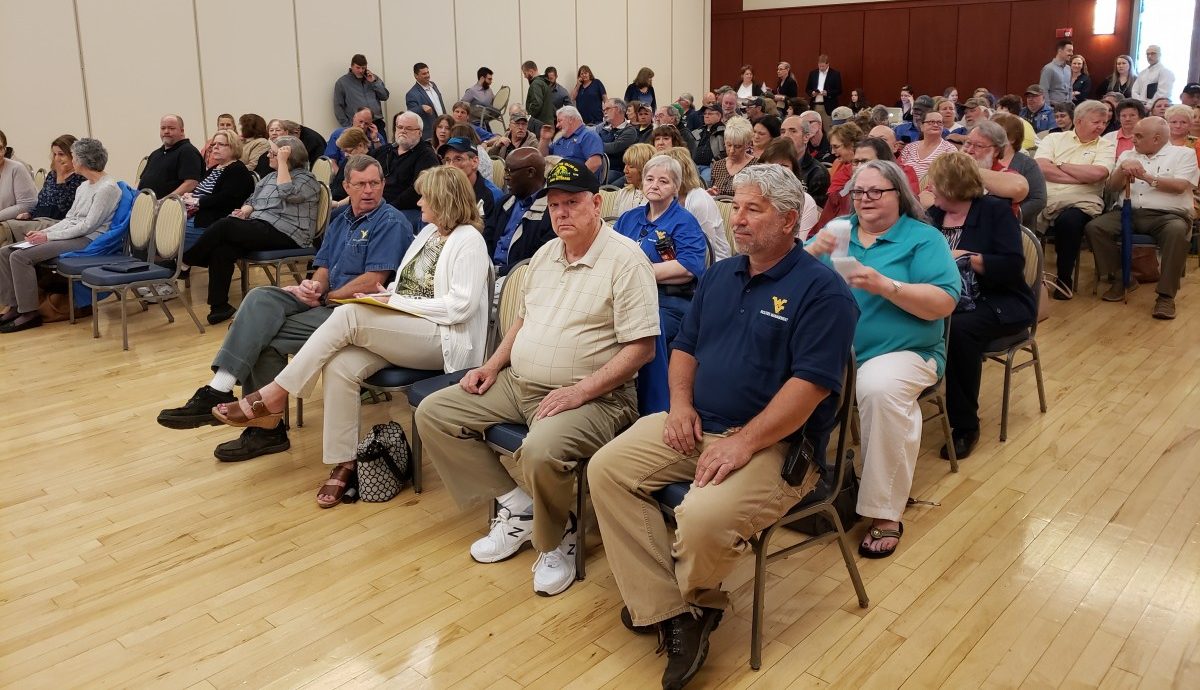MORGANTOWN — About 150 WVU employees gathered at the Erickson Alumni Center Thursday morning to learn about the Voluntary Separation Incentive Program the university is offering to trim personnel and supply costs.

This was the first of two meetings set on the topic. The second will be 1 p.m. Friday at the Mountainlair.
The employees heard an overview of the program and voiced questions about details.
WVU Vice President and Chief Financial Officer Paula Congelio reminded the employees that the university is looking to trim $14.8 million in order to achieve a balanced budget while keeping tuition hikes minimal. The most recent tuition hike, 1.4 percent, was the lowest in 20 years.
The cuts stem from reduced state finding and WU facing the national trend of declining enrolment, she said.

Personnel costs make up about 60 percent of WVU’s budget, she said. Along with seeking savings through attrition, not filling vacancies and some other reductions in non-fixed operating expenses, they’re offering the Voluntary Separation Incentive Program to qualified employees. The VSIP provides a way to streamline operations and adjust workforces at the various schools and units.
“We believe we have a great number of employees who are interested in retirement but might not be sure if they can afford it,” she said.
Cris DeBord, vice president for Talent & Culture, explained how the VSIP will work.
Eligible employees, he said, will be regular benefits-eligible faculty and staff with 20 or more years of service. Research Corporation or Innovation Corporation employees who aren’t state employees are not eligible; nor are those who’ve already set up a retirement dates.
The program offers two exit dates: those who retire or resign effective Dec. 31 will receive 100 percent of their annual base salary in a lump sum payment. Those whose job calendars would require them would step down by June 30, 2020 would receive 50 percent of their primary salary. Some who want alternative dates can be reviewed on case-by-case basis.
They’re hoping to realize $7 million in savings by getting 100 to 150 people of 1,300 eligible employees to sign on. But not everybody who agrees to step down will necessarily be allowed to. The review process will determine if WVU can realize a cost savings by eliminating the person’s role or by restructuring the unit they work in.
Here’s the timeline: All eligible employees have been notified. They have until 5 p.m. May 10 to respond with an expression of interest. Deans and vice presidents will get a list of those who are interested.
From May 11 through early September, a review committee of administrators will review the lists and conduct an operational and financial assessment to see if those positions can be cut. Then, through mid-September, approved employees will be notified.
Approved employees will have 45 days to consider and accept the offer, then another seven days to revoke their acceptance if they change their minds.
“You’ve got time to make sure you really want to do this,” DeBord said.
During the Q&A, employees raised concerns several times about how the lump sum payments would affect their taxes. They feared that the IRS or state Tax Department might view them as suddenly rich and wallop them with big tax bills.
Samantha Burwell, assistant director for HR Strategy & Operations, told them that the lump sum check will come in the next pay cycle following their final paycheck. Deducted from the lump sum will be the federal flat tax, currently 22 percent; state taxes at the rate set by the employee; plus Social Security and Medicare taxes. There will be no option to string the payment out over the course of the year.
Asked if the VSIP is permanent, the officials said yes. State law limits their subsequent pay at a state higher education institution to $5,000. They could go to work at an out-of-state institution or work for another state agency.
DeBord said that the $5,000 limit is out of date and they’re trying to persuade the Legislature to raise it to something reflecting today’s economy. They’d like to be able to re-hire retired faculty as adjuncts.
After the meeting, Congelio answer a couple questions from The Dominion Post.
She explained how they hope to make up the remaining $7.8 million if they realize the full savings of the VSIP program (savings that won’t be seen until Fiscal Year 2021).
Assuming they reach that $7 million, she said, they could realize another $2-plus million in benefits. That gets them close to $10 million and leaves $4.8 million out of a $1 billion budget. “We have expenses spread across all other categories that we’re hopeful to get reductions in.”
Asked if layoffs might be possible, she said they want to streamline in a voluntary way. “That’s not to say, down the road, if a lot of people don’t opt for the voluntary and we still have streamlining we have to do – and again, it’s not urgent, it might be down the road – that’s not to say that we won’t have other reductions in force.”
But all reduction programs generously pay people and provide a cushion for several months, she said.
DeBord had said during the Q&A, “I think we’re going to be OK and we’re going to get to our number.” But Congelio cautioned that it’s not guaranteed. It’s possible that WVU’s review will show that none of 150 or so people who agree to separate can actually be spared. Cutting their positions may achieve no cost savings.
Tweet David Beard @dbeardtdp Email dbeard@dominionpost.com




